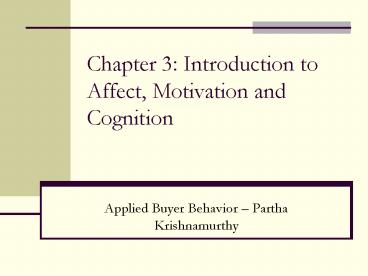Chapter 3: Introduction to Affect, Motivation and Cognition - PowerPoint PPT Presentation
1 / 18
Title:
Chapter 3: Introduction to Affect, Motivation and Cognition
Description:
Chapter 3: Introduction to Affect, Motivation and Cognition ... Feelings: Disgust, Sadness, Warmth, Appreciation. Moods: Blue, Bored, Alert, Relaxed, Calm ... – PowerPoint PPT presentation
Number of Views:793
Avg rating:3.0/5.0
Title: Chapter 3: Introduction to Affect, Motivation and Cognition
1
Chapter 3 Introduction to Affect, Motivation and
Cognition
- Applied Buyer Behavior Partha Krishnamurthy
2
What is Affect?
- A persons feelings about stimuli.
- Events
- Brands
- Prices
- Experiences
- People
- Memories/Anticipations
- Actions
- Feelings!
3
Why Care about Affect?
- Triggers dissatisfaction with current state of
affairs - Impacts how you define your need.
- Influences what you remember.
- Shapes where you shop.
- Impacts your impressions of products and
marketing stimuli - Colors the consumption experience.
4
Nature of the Affective System
- Largely reactive
- Responds immediately
- Responds automatically
- Responses often felt physically in the body
- Responds to various stimuli
- Responses are often learned
5
Structure of Affect and Affective Responses
High Arousal -- Energy
Emotions Anger, Guilt, Fear, Joy
Feelings Disgust, Sadness, Warmth, Appreciation
Unpleasant
Pleasant
Moods Blue, Bored, Alert, Relaxed, Calm
Evaluations Dislike, Bad, Good, Like
Low Arousal -- Energy
6
What is Cognition?
- Plainly, thinking.
- Formally, the mental structures and processes
involved in thinking, understanding, and
interpreting stimuli and events.
7
What Role does Cognition Play?
- Broadly, to interpret and make sense of the
marketing environment, and, ones own responses
to the marketing stimuli. - Understanding interpreting, determining
meanings - Evaluating generating judgments
- Planning problem solving
- Deciding choosing among alternatives
- Thinking the actual cognitive process
8
Cognition Produces
- Knowledge
- About products, advertisements relatively
factual information. - Meanings
- What is the significance to ones self.
- Beliefs
- Similar to knowledge, but more subjective, and
more evaluative
9
The Relationship Between the Affective and
Cognitive Systems
Environment
Affective System
Cognitive System
Affective Responses Emotions Feelings Moods Eval
uations
Cognitive Responses Knowledge Meanings Beliefs
10
Kinds of Issues in Consumer Decision Making
- What product?
- Where to shop?
- What shows to watch?
- How much money to borrow?
- Which friend to consult?
11
Basic Steps in Consumer Decision Making
- Interpret
- To create personal knowledge or meaning
- Integrate
- To combine the interpreted knowledge to judge or
decide action - Retrieve product/self knowledge
- To achieve the above two tasks
12
A Model of Consumer Decision Making
Information in the environment
Interpretation Exposure,attention, and
comprehension
Memory Product knowledge and involvement
Consumer decision making
Knowledge, meanings and beliefs
Integration Attitudes and intentions
Behavior
13
Characteristics of the Cognitive System
- Activation
- Knowledge that comes to mind
- Spreading Activation
- Triggering of related concepts.
- Limited Capacity
- Only a portion of knowledge is active at any
time. - Accelerated Learning
- Routine decisions become less deliberate
14
Types of Knowledge
- General Knowledge
- What links two or more concepts.
- Nikon ---------makes---------professional
cameras. - Kmart ---------is having a---close out sale.
- Procedural Knowledge
- How to act, if-then links between situations
and behavior. - If shopping for home electronics----check out
BestBuy. - If satisfied with service -------leave a generous
tip.
15
Organization of Knowledge
- Knowledge structures
- Link knowledge about related concepts together
Hanes
Jordan
Swoosh
Great Style
Nike
Peewee Football
Costs a ton
Boink!
Comfortable
16
Types of Organized Knowledge
- Schemas
- Organized network of general knowledge
- E.g., all you know about Nike.
- Scripts
- Organized routines of behavioral knowledge
- E.g., sequence of behaviors in a grocery store.
17
Cognitive Learning
- Occurs when consumers interpret information and
create new knowledge or meaning - Via direct product-related experiences
- Via others product experiences
- Via product-related information in the media
18
How Knowledge Changes
- Accretion
- Slowly and gradually add to existing knowledge
- Tuning
- Addition of new knowledge to old that creates new
meanings - Restructuring
- Creation of entirely new knowledge structures or
radical revision of existing knowledge.































